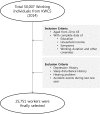The relationship between occupational noise and vibration exposure and headache/eyestrain, based on the fourth Korean Working Condition Survey (KWCS)
- PMID: 28542287
- PMCID: PMC5441589
- DOI: 10.1371/journal.pone.0177846
The relationship between occupational noise and vibration exposure and headache/eyestrain, based on the fourth Korean Working Condition Survey (KWCS)
Abstract
Introduction: The individual and combined effect of occupational noise and vibration exposures, on workers' health has not been thoroughly investigated. In order to find better ways to prevent and manage workers' headache, this study aimed to investigate the effects of occupational noise and vibration exposure on headache/eyestrain.
Methods: We used data from the fourth Korean Working Condition Survey (2014). After applying inclusion and exclusion criteria, 25,751 workers were included. Occupational noise and vibration exposure and the prevalence of headache/eyestrain were investigated by self-reported survey. Chi-square tests were used to compare differences in baseline characteristics between the group with headache/eyestrain and the group without. Odds ratios and 95% confidence intervals were estimated using a logistic regression model adjusted for several covariates. Area under the receiver operating characteristics curve (AUROC) analysis was used to evaluate the effect of occupational noise and/or vibration exposure.
Results: Among the 25,751 study subjects, 4,903 had experienced headache/eyestrain in the preceding year. There were significant differences in age, education level, household income, occupational classification, shift work, occupational vibration exposure, and occupational noise exposure between the two groups (all p<0.05). The odds ratios between each exposure and headache/eyestrain increased proportionally with the level of exposure, increasing from 1.08 to 1.26 with increasing vibration exposure, and from 1.25 to 1.41 with increasing noise exposure. According to the AUROC analysis, the predictive power of each exposure was significant, and increased when the two exposures were considered in combination.
Discussion: The findings of this study show that both occupational noise and vibration exposures are associated with headache/eyestrain; noise exposure more strongly so. However, when the two exposures are considered in combination, the explanatory power for headache/eyestrain is increased. Therefore, efforts aimed at reducing and managing occupational noise and vibration exposure are crucial to maintaining workers' health.
Conflict of interest statement
Similar articles
-
Symptoms of Nervous System Related Disorders Among Workers Exposed to Occupational Noise and Vibration in Korea.J Occup Environ Med. 2017 Feb;59(2):191-197. doi: 10.1097/JOM.0000000000000935. J Occup Environ Med. 2017. PMID: 28166125
-
Relationship between visual display terminal working hours and headache/eyestrain in Korean wage workers during the COVID-19 pandemic: the sixth Korean Working Conditions Survey.Ann Occup Environ Med. 2023 May 9;35:e8. doi: 10.35371/aoem.2023.35.e8. eCollection 2023. Ann Occup Environ Med. 2023. PMID: 37342825 Free PMC article.
-
Asthenopia (eyestrain) in working children of gem-polishing industries.Toxicol Ind Health. 2011 Apr;27(3):243-7. doi: 10.1177/0748233710386407. Epub 2010 Oct 12. Toxicol Ind Health. 2011. PMID: 20940266
-
Relationship between occupational dust exposure levels and mental health symptoms among Korean workers.PLoS One. 2020 Feb 14;15(2):e0228853. doi: 10.1371/journal.pone.0228853. eCollection 2020. PLoS One. 2020. PMID: 32059015 Free PMC article.
-
Effects of noise and vibration on farm workers.Occup Med. 1991 Jul-Sep;6(3):355-69. Occup Med. 1991. PMID: 1948524 Review.
Cited by
-
Temporary Hearing Loss and Associated Factors Among Ayka Addis Textile Factory Workers in Oromia Region, Ethiopia: A Cross-Sectional Study.Risk Manag Healthc Policy. 2021 Feb 18;14:719-728. doi: 10.2147/RMHP.S269609. eCollection 2021. Risk Manag Healthc Policy. 2021. PMID: 33633476 Free PMC article.
-
Proposal of Combined Noise and Hand-Arm Vibration Index for Occupational Exposure: Application to a Study Case in the Olive Sector.Int J Environ Res Public Health. 2022 Nov 2;19(21):14345. doi: 10.3390/ijerph192114345. Int J Environ Res Public Health. 2022. PMID: 36361218 Free PMC article.
-
Association between Occupational Noise and Vibration Exposure and Insomnia among Workers in Korea.Life (Basel). 2020 Apr 22;10(4):46. doi: 10.3390/life10040046. Life (Basel). 2020. PMID: 32331422 Free PMC article.
-
Personal Listening Device Use and Attitude to Noise in Relation to Depression and Anxiety among Medical Students.Noise Health. 2023 Jul-Sep;25(118):176-182. doi: 10.4103/nah.nah_27_23. Noise Health. 2023. PMID: 37815079 Free PMC article.
-
Exploring the link between pediatric headaches and environmental noise exposure.BMC Pediatr. 2024 Feb 2;24(1):94. doi: 10.1186/s12887-023-04490-4. BMC Pediatr. 2024. PMID: 38308216 Free PMC article. Review.
References
-
- Seong JC, Park TH, Ko JH, Chang SI, Kim M, Holt JB, et al. Modeling of road traffic noise and estimated human exposure in Fulton County, Georgia, USA. Environ Int. 2011;37: 1336–1341. doi: 10.1016/j.envint.2011.05.019 - DOI - PubMed
-
- Erdogan E, Yazgan ME. Landscaping in reducing traffic noise problem in cities: Ankara case. African Journal of Agricultural Research. 2009;4: 1015–1022.
-
- Lee H-S, Choi S-B. Control and response characteristics of a magneto-rheological fluid damper for passenger vehicles. J Intell Mater Syst Struct. 2000;11: 80–87.
-
- Lang T, Fouriaud C, Jacquinet-Salord M-C. Length of occupational noise exposure and blood pressure. Int Arch Occup Environ Health. 1992;63: 369–372. - PubMed
MeSH terms
LinkOut - more resources
Full Text Sources
Other Literature Sources
Medical


